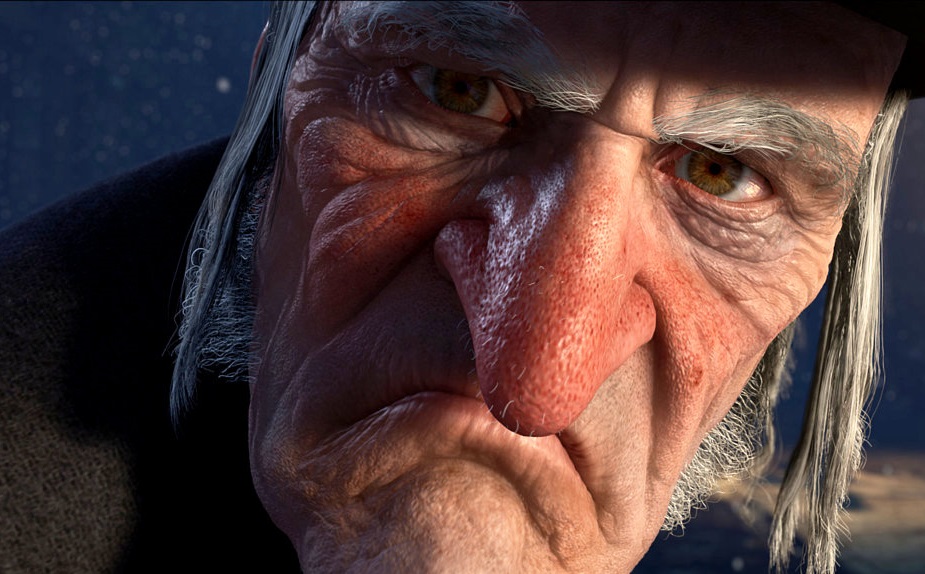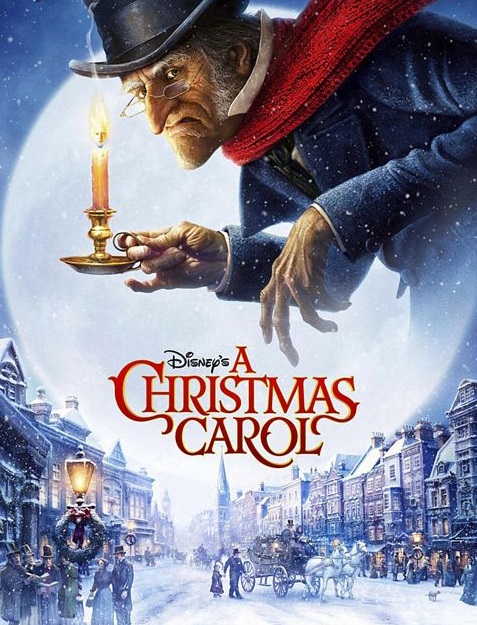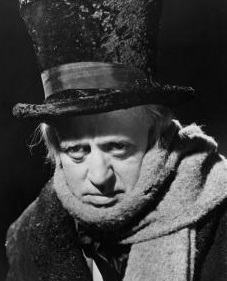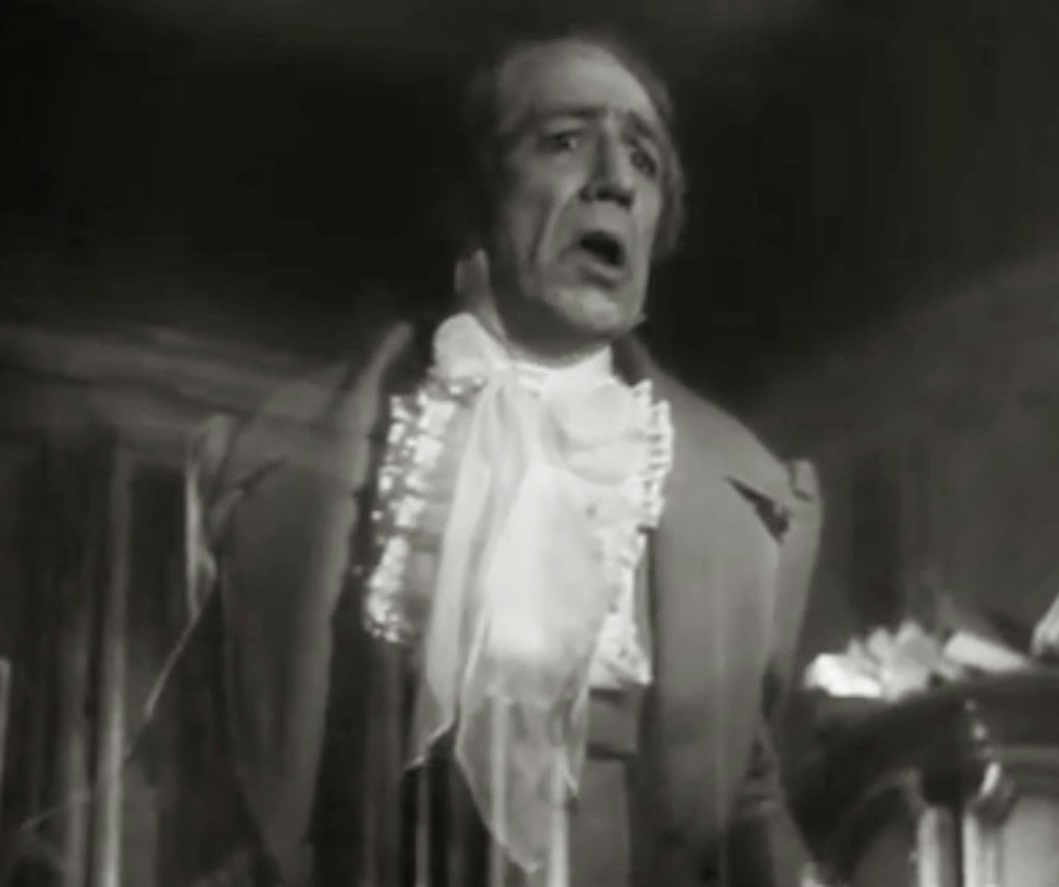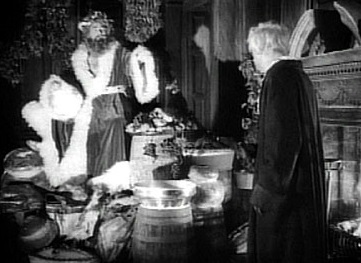NOTE: This article assumes that the reader is familiar with the basic story of A Christmas Carol, and it will be covering scenes from both films in detail. As such, there are spoilers, so consider yourself warned!
Over the years, Charles Dickens’ A Christmas Carol has remained one of the most famous stories of all time. Nearly 200 years after its original publication, it remains one of the most filmed stories ever, and one that has never diminished in terms of its popularity or relevance.
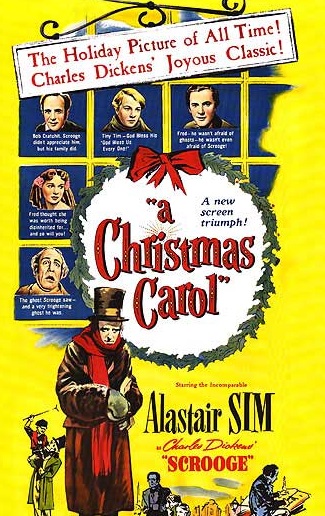
With the Holiday Season around the corner, I thought it would be a fun time to take a look at two filmed versions of A Christmas Carol, and see how they stack up and compare to one another. For the purposes of this article, we will be looking at the 1951 live action version of the story starring Alastair Sim as Scrooge, and the 2009 CGI/motion capture version from director Robert Zemeckis.
No matter what version of the story you are watching/reading/seeing performed/etc., the basic story of A Christmas Carol remains the same. Rich, rude old miser Ebenezer Scrooge runs his own company, and is a self-centered man who has hoarded money for years and mistreats his employees. On Christmas Eve, he is visited by the ghost of his former business partner, Jacob Marley, who tells Scrooge that he will be seeing three ghosts that will show him the errors and consequences of his ways over the years, and that he may have a chance of escaping eternal damnation for his wrongdoings. As the night progresses, he is visited by ghosts that show him visions of his past, present, and even his future. Of course, eventually he awakens the next morning a changed man, opting to use his wealth to help others, treating his employees better, and taking a considerably more optimistic approach to Christmas.
The 1951 version of the story (originally released in British theaters under the name Scrooge) is directed by Brian Desmond-Hurst, and stars Alastair Sim as Scrooge, with a supporting cast that includes Mervyn Johns as Bob Crachit, Glyn Dearman as Tiny Tim, and Jack Warner as Mr. Jorkin, a new character created for this adaptation.
The 2009 version of the story, done with CGI and motion capture, is directed by Robert Zemeckis (Back to the Future, Forrest Gump, The Polar Express) and stars Jim Carrey as Scrooge and the Ghosts of Christmas Past, Present, and Future, Gary Oldman as Bob Cratchit and Jacob Marley, and Robin Wright Penn as Fan and Belle.
For this article, we will look at the various aspects of the films, comparing them to one another and seeing if one version of the movie is the superior one. Both films are adaptations of the same story, but in a number of regards the stories are drastically different, and not just because of the technology and special effects progress over nearly 60 years!
THE OPENING SCENES/CREDITS:
In the 1951 version of the story, the opening features an unnamed individual taking the book of A Christmas Carol off of a bookshelf with other Charles Dickens stories, and opening it up; the opening credits then play on the pages of the book as the pages turn. Said credits are accompanied by Christmas carols spliced with dark, downbeat orchestral sounds. Narration (by Peter Bull, who also plays one of the men of business in the film) starts off the story following the credits.
In the 2009 version, we see the book being opened, and a new added opening scene in which Scrooge must sign the registry for Jacob Marley’s burial; these scenes take place seven years prior to the “main” film. Scrooge is reluctant to pay the undertaker, and after doing so, steals the coins from the dead Marley’s eyes before the undertaker’s assistant can nail the casket shut. The opening credits themselves are played over the hustle and bustle of London, with people going about their holiday business.
Quite honestly, both films handle these scenes well, but in different ways. The 1951 version keeps things low key and dark, just the way this story needs to be treated. The scene of Scrooge signing the death certificate for Jacob Marley is one of the few scenes I generally enjoy that was added to the 2009 version; it beautifully demonstrates how greedy and unfavorable a character Scrooge is. The weakness in this version of the film’s opening is that the opening credits sequence is far too romanticized; these happy people out in a brightly lit London hardly represent the gloomy, dirty Victorian era that Dickens so brilliantly wrote about. For this reason, the 1951 version’s “less is more” approach makes it the winner.
Winner: 1951
BEFORE THE GHOSTS ARRIVE:
In the 1951 version, we get the classic scenes of Scrooge talking poorly to Bob Cratchit, rejecting the charitable pleas of two men of business, and turning down his nephew Fred’s invitation to Christmas dinner. We then see Scrooge leave the office, dining in a restaurant in which he rejects his earlier plea for more bread upon learning that it will cost him more.
Honestly, the 2009 version is not a whole lot different in this regard; we see similar versions of the scenes in question, albeit with a nice addition of Bob Cratchit being berated for clapping enthusiastically to Fred’s speech about the joys of Christmas (this scene was in the original story but omitted in the older film). It lacks the scene of Scrooge dining, however, which would have been nice for the sake of character development, and the later “more gravy than a grave” speech. Instead we get scenes of Cratchit racing home to his family, and gliding on the ice, mimicking some young kids. This is one of many “action” scenes added to the 2009 version that was largely unnecessary and a distraction.
So while the 2009 version handles much of this material well, the unneeded scenes of Cratchit on the ice weigh it down.
Winner: 1951
MARLEY’S GHOST:
In the 1951 version, we see Jacob Marley’s face on the doorknocker, followed by his encounter with Scrooge, and Scrooge’s initial doubts. Marley lets out unearthly screams, telling Scrooge of the Ghosts that will come later, and then directs Scrooge’s attention outside the window, showing spirits haunting the streets.
The 2009 version falters in this scene for a number of reasons, adding an unnecessary startling moment to the “doorknocker” scene, and actually bringing slapstick comedy into the “mankind was my business” speech, which is supposed to be one of the most emotional speeches in the story, but here it becomes reduced to a joke. However the scene DOES retain the element of ghosts in the streets.
Honestly, even the 1951 version of this scene is a little bit on the campy side, but it at least shows greater reverence to the source material than the Zemeckis scene. The unneeded humor in the 2009 version ruins the scene.
Winner: 1951
THE GHOST OF CHRISTMAS PAST:
Of the three Ghosts, Christmas Past is the one that differs most substantially between the various film adaptations of the story; a 1984 version of the story starring George C. Scott even features this character as a female!
In the 1951 version, the Ghost is a kindly, gentle old man, but one who insists upon Scrooge seeing his past misdeeds.
In the 2009 version, the Ghost looks like a strange combination between a ghost and a candle, holding the candle extinguishing funnel device that most versions of the character have.
This is one area where the 2009 version succeeds, largely due to increases in technology. The 1951 version of this character is not bad, but seems rather bland, and lacks the descriptors from Dickens’ original text of candle-like light emanating from his body, and the candle extinguisher. The 2009 version looks like an unearthly ghost should, which helps to give some atmosphere to the later version of the story.
Winner: 2009
SCROOGE’S FAMILY:
In the 1951 version, we are treated to young Scrooge alone at a boarding school, with his sister Fan coming and telling him that their father is less angry than he once was, and that he can now return home to live again. In this version, unlike the original Dickens tale, Fan is older, but the bond between the two in this scene is undeniable. Later in the film, in a change to the story, Fan dies giving birth to her child (Scrooge’s nephew), causing Scrooge to resent the child as Scrooge was resented by his own father as his mother had died in childbirth.
In the 2009 version, Fan remains younger as she was in the original story, and this scene is equally effective and powerful. And like the original story, her cause of death is never mentioned.
Usually I am opposed when a film version of a story makes changes to the source material, but this is a powerful change that actually makes the story MORE effective, and makes Scrooge’s subsequent guilt trip and journey back to goodness all the more potent. The 2009 version does not really do anything wrong here; it is just being true to the source material. But this is an instant in which a change is for the best.
Winner: 1951
SCROOGE’S EMPLOYMENT:
This is probably the biggest change from the source material, but it is also the one that truly makes this version of the story stand out. Scrooge goes to work as an apprentice for Fezziwig, but in this version of the story he is lured away to work for a ruthless employer, Mr. Jorkin (played by Jack Warner). Over the years, Scrooge and his new business partner Jacob Marley become quite wealthy working for Jorkin’s company, and later at a meeting it is revealed that Jorkin is an embezzler and the company has no money remaining as a result of this. Word of it cannot get out, as the company would suffer publicly as a result. Scrooge and Marley come up with a solution, agreeing to cover the financial voids of the company out of their own pockets, but in exchange they will be allowed to buy more stock in the company, becoming the majority shareholders. The other members of the board of directors are not pleased with the idea, but ultimately accept, and this results in the creation of the Scrooge and Marley company. There are also added scenes of Fezziwig going out of business; apparently being bought out by Jorkin’s company.
The 2009 version more or less stays true to the source material, and features scenes depicting Fezziwig as a benevolent business man. Again, this version of the story does not really do anything wrong, but the “Mr. Jorkin” subplot is so seamlessly inserted into the 1951 version and does such a good job establishing backstory where there was none before. The results work surprisingly well.
Winner 1951
SCROOGE’S LOVE:
A major plot point of the story is revisiting the woman Scrooge once loved, and how his pursuits of business and money ultimately drove her away. A brief scene later in the original story shows her having married and had children with another man.
In the 1951 version of the story, the love interest is named Alice (changed from “Belle” in the original story). We see scenes of them initially being engaged to one another, and the subsequent split when it becomes clear that she no longer approves of his self-centered pursuits, ultimately bursting into tears when Scrooge leaves her. Later in the story, we see her working with and helping the poor, continuing to walk a positive path in life.
One of the major weaknesses of the 2009 version of the movie is how lazily it handles this plot point. We see the scene of them first meeting and having their engagement… and the scene of their split comes IMMEDIATELY AFTER, with no breathing room. And no scenes in between of Scrooge’s business pursuits. And this is it. The character is more or less cast aside after this. When you consider some of the action filler that was inserted into this version of the story, and that something like this could be rushed, and with the aftermath scene not even appearing in the final movie (a rough version appears as a deleted scene on some home video releases), it truly feels like a missed opportunity in an otherwise mostly solid film.
Winner: 1951
ADDITIONAL SCENES IN THE PAST:
The 1951 version features Scrooge stubbornly refusing to go to the bedside of a dying Jacob Marley until business for the evening has concluded, he then meets the undertaker (played by Ernest Thesiger, best known for having portrayed Dr. Pretorius in Bride of Frankenstein) and converses with the dying Marley, who tries to tell Scrooge that their selfish pursuits have been wrong.
The 2009 version features a more faithful version of Scrooge “extinguishing” the Ghost of Christmas Past, but needlessly adds in another “action” scene in which doing so propels him into the sky above the city, and comes crashing down. Not surprisingly, scenes like this are the biggest weakness of the 2009 version.
Winner: 1951
THE GHOST OF CHRISTMAS PRESENT:
In the 1951 version, the Ghost is presented in a manner faithful to Dickens’ text; a large, bearded man dressed in a fine robe. He then proceeds to show Scrooge how things are going about in the present day.
The Ghost looks the same in the 2009 version, albeit larger. He transforms and changes the room that he and Scrooge are inside of, so that they can see visions of the present through a transparent portion of the floor.
Again, it comes down to a matter of “less is more,” and the 2009 version tries to make things here a little too “over the top.”
Winner: 1951
THE CRATCHIT FAMILY:
The 1951 version features an added scene at the beginning of the movie where we see Tiny Tim, the youngest Cratchit child and an ill cripple, looking into a store window at fancy Victorian era toys. A toy is then bought out of the window, presumably going to some other more fortunate child. Despite this, Tim remains optimistic and has a happy outlook on life. We then move on to the Cratchit Christmas dinner, with the family meeting and enjoying what they have despite minimal income. Bob Cratchit (the head of the household that works for Scrooge) proposes a toast to Scrooge being the “founder of their feast,” much to the chagrin of his family, particularly his wife. We can clearly see both Cratchit parents are afraid that Tim is becoming weaker and could potentially die.
The 2009 version, like the original text, does not introduce Tiny Tim until this scene, so the development from earlier in the movie is absent. For the most part, this scene goes like the original story and the 1951 version.
This one goes to the 1951 version, because it takes the initiative of introducing Tim earlier in the film. This means that when we hear he may die, we are more upset as an audience, unlike in the 2009 version, where we have just met and first seen the boy.
Winner: 1951
FRED IN THE PRESENT:
The 1951 version shows Fred and friends celebrating Christmas, and some jokes are made about Scrooge. Fred defends him nonetheless, even going so far as to (jokingly) state that he only cheated himself out of a barely digestible dinner by not attending!
The 2009 version is truer to the original story, with the “similes” game being played, and Scrooge being likened to an ass (a donkey).
This is yet another instance where the changes actually improve the story. The “similes” game, in this fan’s opinion, never really added much to the original story to begin with, and the speech in the 1951 version actually remains more powerful and effective.
Winner: 1951
FROM PRESENT TO FUTURE:
In the 1951 version, the Ghost of Christmas Present’s time with Scrooge draws to an end, he torments Scrooge with Scrooge’s own past words when he shows concern for the safety of the “Ignorance and Want” children. A frightened Scrooge then rushes off, to be stopped by the dark robed Ghost of Christmas Yet to Come.
Again, the 2009 version goes “over the top,” showing the ghost deform and his flesh fall away to reveal a skeleton beneath. The “Ignorance and Want” children grow into adults, and it is THEM that taunt Scrooge with his past words, and they are shown in situations depicting the words in question. One thing I admire about the 2009 version is that, despite being a PG-rated family oriented movie, it did not “tone things down” from the original story, but this scene is almost a little TOO dark and disturbing.
Winner: 1951
INTRO TO THE FUTURE:
This scene is only present in the 2009 version, and it is by far the biggest weakness of the film, taking away and distracting from an otherwise solid movie and its great performances. A phantom carriage chases Scrooge across the streets of London, through back alleys, with plenty of physical action occurring, including Scrooge shrinking and finding himself in pipes, getting away from the spirit, then viewing much of what is going on in the unchanged future.
This scene added absolutely nothing to the story. When you consider we get this instead of scenes like Scrooge in the restaurant early in the film, and instead of seeing what became of his former love, it makes things all the more disappointing. This entire sequence could easily have been excised, with no loss to the main story.
Winner: 1951 (for NOT having this needless filler scene).
THE GHOST OF CHRISTMAS YET TO COME:
This is the toughest one of the Ghosts to rate, as the character is barely in the film, does not speak, and more or less resembles the stereotypical depiction of the Grim Reaper.
In the 1951 version, it is simply a hooded reaper-like figure that extends a hand.
The 2009 version features the Ghost appearing in the form of a shadow that takes this shape as well.
Really, neither version of the character is better or worse than the other.
Winner: Tie
SCENES OF THE FUTURE:
Both versions of the story show a number of scenes of what happens in the future that will result from Scrooge not changing his ways. This includes the Cratchit family mourning Tiny Tim’s death, assorted people selling a recently deceased man’s belongings, and talk about the death of a man at the exchange in which Scrooge conducts business.
Again, the 1951 version has an edge since we saw Scrooge at the exchange earlier in the movie and making his ruthless business persona known. Likewise, the “people selling stuff” scene suffers because we still have a shrunken Scrooge present, and he is nearly hit by a fireplace poker as the man running the shop tries to kill a rat. Aside from that latter scene, this is fairly faithful in the 2009 version. But the 1951 version wins again with its “less is more” approach.
Winner: 1951
THE GRAVEYARD:
One of the most famous scenes of the story. Scrooge is unclear as to who the “dead man” is whose belongings were being sold. The Ghost of Christmas Yet to Come reveals that the grave is his own, showing him that not changing his ways will result in his own death coming sooner.
This is one of the few scenes where the 2009 version really has the edge. In the 1951 version, we simply see a frightened Scrooge in the graveyard, seeing his name on the tombstone, and screaming out. In the 2009 version, the Ghost very gradually reveals the information on the snow covered grave, little by little. Scrooge then dangles above his grave hole, the fires of Hell burning below the casket.
A scene like this requires the dramatic flair and edge that the 2009 version brought to the table, and as such, it is one of the few scenes to actually benefit from this approach.
Winner: 2009
AWAKENING THE NEXT MORNING:
Scrooge wakes up the next morning, eager to be a changed man and celebrate Christmas.
In both versions, we see scenes of Scrooge treating his housekeeper kindly, only to have her freak out, thinking he has gone insane. Scrooge also yells out his window to a young boy, telling him to go to a butcher shop and bring the enormous prize bird hanging in the window, so that he may send it to Bob Cratchit’s family so that they may have a quality feast.
The scenes of an insanely happy Scrooge go on longer in the 1951 version. This time around, it is actually the 2009 version that takes the “less is more” approach, oddly enough! Still, both versions of the film are fairly faithful to the original story here, so there is no clear winner.
Winner: Tie
CHRISTMAS DAY:
We see Scrooge go about his Christmas day, with the highlight being him attending the dinner his nephew Fred was putting on.
In the 1951 version, we see Scrooge go over and deliver a heartfelt apology to Fred and his wife. He then proceeds to dine with them. This version of the film also includes another powerful scene; the Cratchit family is enjoying their prize bird for Christmas dinner. The family is unclear of where it came from, but Tiny Tim seems to be the one person to believe it was Scrooge that sent it.
The 2009 version has a rather comical scene coinciding with the “similes” game; just as one of the party guests is about to guess Scrooge, he enters the room. This version has its own emotional scene, in which Scrooge encounters one of the men of business from Christmas Eve that was taking up a charitable collection. He apologizes for his words the previous day, whispering a dollar figure into the man’s ear, claiming a good many “back payments” are included (this scene was in the original story, but startlingly does not appear in the 1951 film).
We get two versions of this day that are quite different from one another for the aforementioned reasons, and both are powerful in their own way. Neither one is the clear winner here; both succeed in their own ways.
Winner: Tie
THE DAY AFTER CHRISTMAS:
Scrooge returns to his place of business, with Bob Cratchit entering late. A seemingly angry Scrooge demands that he steps into his office, and that he “won’t stand for this sort of thing anymore.” But in what Cratchit expects to be an angry berating, Scrooge says that he will raise his salary, revealing that it was all an act. Scrooge even says he wants to help him to raise his family through the tough times.
Again, this is another scene where neither version is really better or worse than the other. Both get the job done well, and do justice to the original story’s resolution.
Winner: Tie
THE ENDING:
The narration states that Scrooge became a good and beloved man.
In the 1951 version, we see a great final scene of Tiny Tim rushing to meet Scrooge, without the use of a crutch, implying that he has gotten well thanks to Scrooge’s intervention, as well as more narration from Peter Bull.
In the 2009 version, there is a rather odd turn, in this final scene, Bob Cratchit breaks the fourth wall and does the “ending narration” himself, and we see Scrooge walk past with Tim on his shoulder.
The simplicity and effectiveness of the 1951 version makes it the superior choice here. That is not to say the 2009 version handles this poorly, even if the Cratchit narration is a bit of an odd choice.
Winner: 1951
It is great to look at both of these film versions of the Christmas classic. Based on which film “wins” more of the above categories, it is clear that I prefer the 1951 version; it tends to be a little darker and more “low key,” and this generally works better for the tone of the tale. That said, I still applaud the 2009 version for staying true to the tone of the original story and not trying to “tone it down” for kids. Really, both versions (and several other film versions of the story out there) are definitely worth watching come the Holiday Season.
Both films are available on Blu-ray Disc, featuring a number of extras, including some rough deleted scenes on the 2009 version’s disc.
All images and are the copyright of their respective holders. For promotional purposes only. All rights reserved.

